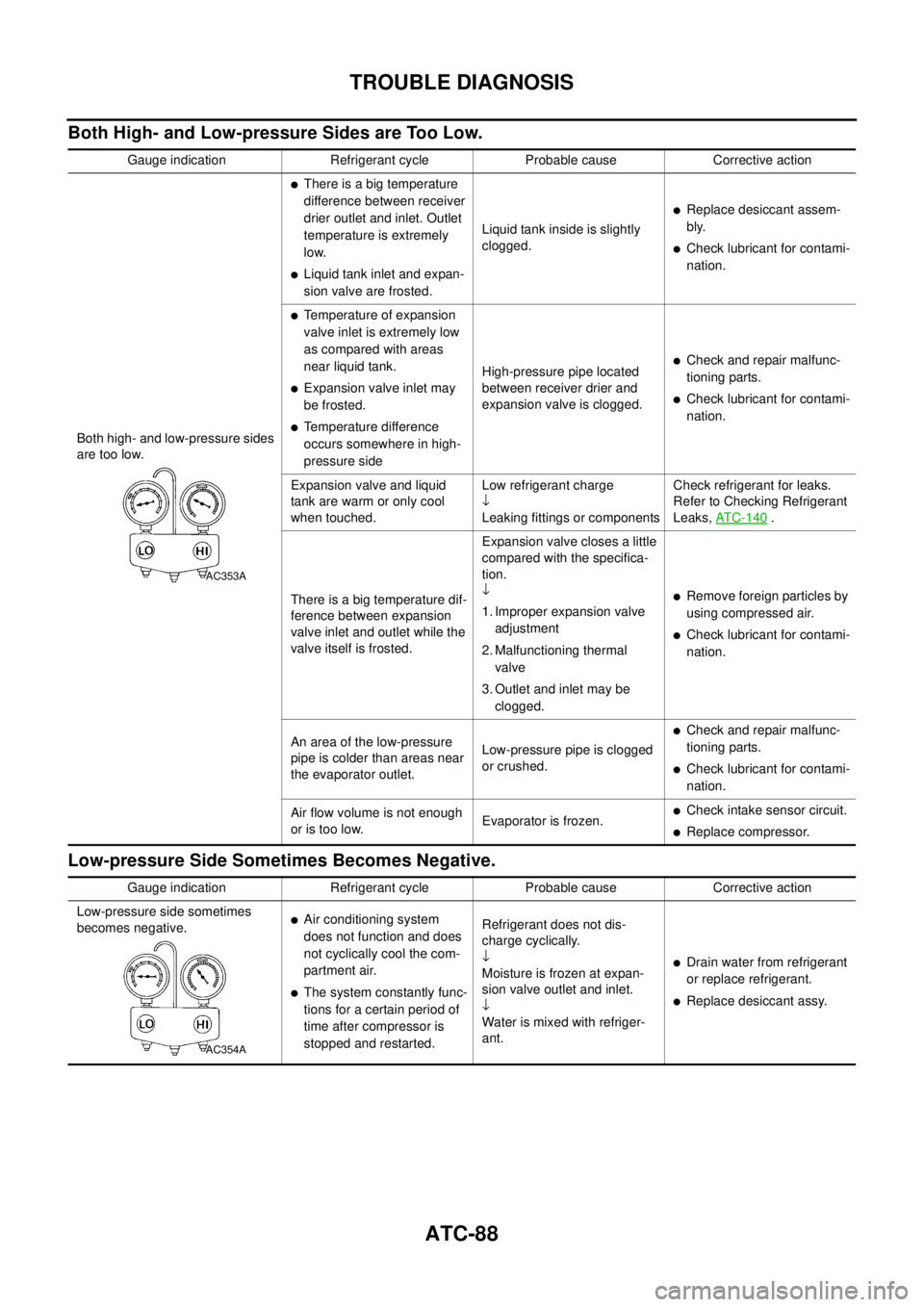air conditioning NISSAN X-TRAIL 2003 Electronic Repair Manual
[x] Cancel search | Manufacturer: NISSAN, Model Year: 2003, Model line: X-TRAIL, Model: NISSAN X-TRAIL 2003Pages: 3066, PDF Size: 51.47 MB
Page 582 of 3066

ATC-4
PRECAUTIONS
PRECAUTIONS
PFP:00001
Precautions for Supplemental Restraint System (SRS) “AIR BAG” and “SEAT
BELT PRE-TENSIONER”
EJS000T0
The Supplemental Restraint System such as “AIR BAG” and “SEAT BELT PRE-TENSIONER”, used along
with a front seat belt, helps to reduce the risk or severity of injury to the driver and front passenger for certain
types of collision. Information necessary to service the system safely is included in the SRS and SB section of
this Service Manual.
WAR NIN G:
lTo avoid rendering the SRS inoperative, which could increase the risk of personal injury or death
in the event of a collision which would result in air bag inflation, all maintenance must be per-
formed by an authorized NISSAN/INFINITI dealer.
lImproper maintenance, including incorrect removal and installation of the SRS, can lead to per-
sonal injury caused by unintentional activation of the system. For removal of Spiral Cable and Air
Bag Module, see the SRS section.
lDo not use electrical test equipment on any circuit related to the SRS unless instructed to in this
Service Manual. SRS wiring harnesses can be identified by yellow harness connectors.
Precautions for Working with HFC-134a (R-134a)EJS000T1
WAR NIN G:
lUse only specified lubricant for the HFC-134a (R-134a) A/C system and HFC-134a (R-134a) compo-
nents. If lubricant other than that specified is used, compressor failure is likely to occur.
lThe specified HFC-134a (R-134a) lubricant rapidly absorbs moisture from the atmosphere. The fol-
lowing handling precautions must be observed:
–When removing refrigerant components from a vehicle, immediately cap (seal) the component to
minimize the entry of moisture from the atmosphere.
–When installing refrigerant components to a vehicle, do not remove the caps (unseal) until just
before connecting the components. Connect all refrigerant loop components as quickly as possi-
bletominimizetheentryofmoistureintosystem.
–Only use the specified lubricant from a sealed container. Immediately reseal containers of lubri-
cant. Without proper sealing, lubricant will become moisture saturated and should not be used.
–Avoid breathing A/C refrigerant and lubricant vapor or mist. Exposure may irritate eyes, nose and
throat. Remove R-134a from the A/C system, using certified service equipment meeting require-
ments of SAE J2210 (R-134a recycling equipment), or J2209 (R-134a recovery equipment). If acci-
dental system discharge occurs, ventilate work area before resuming service. Additional health
and safety information may be obtained from refrigerant and lubricant manufacturers.
–Do not allow lubricant (Nissan A/C System Oil Type S) to come in contact with styrofoam parts.
Damage may result.
General Refrigerant PrecautionsEJS000T2
WAR NIN G:
lDo not release refrigerant into the air. Use approved recovery/recycling equipment to capture the
refrigerant every time an air conditioning system is discharged.
lAlways wear eye and hand protection (goggles and gloves) when working with any refrigerant or
air conditioning system.
lDo not store or heat refrigerant containers above 52°C(125°F).
lDo not heat a refrigerant container with an open flame; if container warming is required, place the
bottom of the container in a warm pail of water.
lDo not intentionally drop, puncture, or incinerate refrigerant containers.
lKeep refrigerant away from open flames: poisonous gas will be produced if refrigerant burns.
lRefrigerant will displace oxygen, therefore be certain to work in well ventilated areas to prevent
suffocation.
lDo not pressure test or leak test HFC-134a (R-134a) service equipment and/or vehicle air condi-
tioning systems with compressed air during repair. Some mixtures of air and R-134a have been
shown to be combustible at elevated pressures. These mixtures, if ignited, may cause injury or
Page 595 of 3066
![NISSAN X-TRAIL 2003 Electronic Repair Manual REFRIGERATION SYSTEM
ATC-17
C
D
E
F
G
H
I
K
L
MA
B
AT C
cm2, 540 psi)], the release port on the pressure relief valve automatically opens and releases refrigerant into
the atmosphere.
V-6 Variable Dis NISSAN X-TRAIL 2003 Electronic Repair Manual REFRIGERATION SYSTEM
ATC-17
C
D
E
F
G
H
I
K
L
MA
B
AT C
cm2, 540 psi)], the release port on the pressure relief valve automatically opens and releases refrigerant into
the atmosphere.
V-6 Variable Dis](/img/5/57402/w960_57402-594.png)
REFRIGERATION SYSTEM
ATC-17
C
D
E
F
G
H
I
K
L
MA
B
AT C
cm2, 540 psi)], the release port on the pressure relief valve automatically opens and releases refrigerant into
the atmosphere.
V-6 Variable Displacement Compressor (With Gasoline Engine: CWV-165M
Compressor)
EJS000TF
GENERAL INFORMATION
1. The V-6 variable compressor differs from previous units. The vent temperatures of the V-6 variable com-
pressor do not drop too far below 5°C(41°F) when:
Evaporator intake air temperature is less than 20°C(68°F).
Engine is running at speeds less than 1,500 rpm.
This is because the V-6 compressor provides a means of "capacity" control.
2. The V-6 variable compressor provides refrigerant control under varying conditions. During cold winters, it
may not produce high refrigerant pressure discharge (compared to previous units) when used with air
conditioning systems.
3. A "clanking" sound may occasionally be heard during refrigerant charge. The sound indicates that the tilt
angle of the swash plate has changed and is not a problem.
4. For air conditioning systems with the V-6 compressor, the clutch remains engaged unless: the system
main switch, fan switch or ignition switch is turned OFF. When ambient (outside) temperatures are low or
when the amount of refrigerant is insufficient, the clutch is disengaged to protect the compressor.
5. A constant range of suction pressure is maintained when engine speed is greater than a certain value. It
normally ranges from 147 to 177 kPa (1.5 to 1.8 kg/cm
2, 21 to 26 psi) under varying conditions.
In previous compressors, however, suction pressure was reduced with increases in engine speed.
DESCRIPTION
General
The variable compressor is basically a swash plate type that changes piston stroke in response to the required
cooling capacity.
RJIA0198E
Page 663 of 3066

TROUBLE DIAGNOSIS
ATC-85
C
D
E
F
G
H
I
K
L
MA
B
AT C
Test Reading (QR engine)
Recirculating-to-discharge Air Temperature Table
Ambient Air Temperature-to-operating Pressure Table
Test Reading (YD engine)
Recirculating-to-discharge Air Temperature Table
Ambient Air Temperature-to-operating Pressure Table
Vehicle location Indoors or in the shade (in a well-ventilated place)
Doors Closed
Door windows Open
Hood Open
TEMP. Max. COLD
Mode switch (Ventilation) set
Intake switch (Recirculation) set
(blower) speedMax. speed set
Engine speed Idle speed
Operate the air conditioning system for 10 minutes before taking measurements.
Inside air (Recirculating air) at blower assembly inlet
Discharge air temperature at center ventilator
°C(°F) Relative humidity
%Air temperature
°C(°F)
50 - 6025 (77) 10.0 - 11.6 (50 - 53 )
30 (86) 13.9 - 16.2 (57 - 61)
35 (95) 17.8 - 21.4 (64 - 71)
60 - 7025 (77) 11.6 - 13.9 (53 - 57)
30 (86) 16.2 - 18.9 (61 - 66)
35 (95) 21.4 - 24.5 (71 - 76)
Ambient air
High-pressure (Discharge side)
kPa (kg/cm2, psi)Low-pressure (Suction side)
kPa (kg/cm2, psi) Relative humidity
%Air temperature
°C(°F)
50 - 7030 (86)980 - 1,180
( 9.99 - 12.04 , 142 - 171)230 - 270 (2.35 - 2.75, 33 - 39)
35 (95)1,180 - 1,390
(12.04 - 14.18 , 171 - 202)260 - 310 (2.65 - 3.16, 38 - 45)
40 (104)1,400 - 1,580
( 14.28 - 16.12 , 203 - 229)300 - 350 (3.06 - 3.57, 44 - 51)
Inside air (Recirculating air) at blower assembly inlet
Discharge air temperature at center ventilator
°C(°F) Relative humidity
%Air temperature
°C(°F)
50 - 6020 (68) 6.5 - 9.0 (44 - 48)
25(77) 12 - 14(54 - 57)
30 (86) 15.5 - 18.8 (60 - 66)
35 (95) 20.4 - 24.0 (69 - 75)
60 - 7020 (68) 9.0 - 11.0 (48 - 52)
25(77) 14.0 - 16.5 (57 - 62)
30 (86) 18.8 - 21.5 (66 - 71)
35 (95) 24 - 27 (75 - 81)
Page 666 of 3066

ATC-88
TROUBLE DIAGNOSIS
Both High- and Low-pressure Sides are Too Low.
Low-pressure Side Sometimes Becomes Negative.
Gauge indication Refrigerant cycle Probable cause Corrective action
Both high- and low-pressure sides
are too low.
lThere is a big temperature
difference between receiver
drier outlet and inlet. Outlet
temperature is extremely
low.
lLiquid tank inlet and expan-
sion valve are frosted.Liquid tank inside is slightly
clogged.
lReplace desiccant assem-
bly.
lCheck lubricant for contami-
nation.
lTemperature of expansion
valve inlet is extremely low
as compared with areas
near liquid tank.
lExpansion valve inlet may
be frosted.
lTemperature difference
occurs somewhere in high-
pressure sideHigh-pressure pipe located
between receiver drier and
expansion valve is clogged.
lCheck and repair malfunc-
tioning parts.
lCheck lubricant for contami-
nation.
Expansion valve and liquid
tank are warm or only cool
when touched.Low refrigerant charge
¯
Leaking fittings or componentsCheck refrigerant for leaks.
Refer to Checking Refrigerant
Leaks,AT C - 1 4 0
.
There is a big temperature dif-
ference between expansion
valve inlet and outlet while the
valve itself is frosted.Expansion valve closes a little
compared with the specifica-
tion.
¯
1. Improper expansion valve
adjustment
2. Malfunctioning thermal
valve
3. Outlet and inlet may be
clogged.
lRemove foreign particles by
using compressed air.
lCheck lubricant for contami-
nation.
An area of the low-pressure
pipe is colder than areas near
the evaporator outlet.Low-pressure pipe is clogged
or crushed.
lCheck and repair malfunc-
tioning parts.
lCheck lubricant for contami-
nation.
Air flow volume is not enough
or is too low.Evaporator is frozen.
lCheck intake sensor circuit.
lReplace compressor.
AC353A
Gauge indication Refrigerant cycle Probable cause Corrective action
Low-pressure side sometimes
becomes negative.
lAir conditioning system
does not function and does
not cyclically cool the com-
partment air.
lThe system constantly func-
tions for a certain period of
time after compressor is
stopped and restarted.Refrigerant does not dis-
charge cyclically.
¯
Moisture is frozen at expan-
sion valve outlet and inlet.
¯
Water is mixed with refriger-
ant.
lDrain water from refrigerant
or replace refrigerant.
lReplace desiccant assy.
AC354A
Page 1115 of 3066

EC-1
ENGINE CONTROL SYSTEM
B ENGINE
CONTENTS
C
D
E
F
G
H
I
J
K
L
M
SECTION
A
EC
ENGINE CONTROL SYSTEM
QR (WITH EURO-OBD)
INDEX FOR DTC ...................................................... 12
Alphabetical Index .................................................. 12
DTC No. Index ....................................................... 14
PRECAUTIONS ........................................................ 16
Precautions for Supplemental Restraint System
(SRS) “AIR BAG” and “SEAT BELT PRE-TEN-
SIONER” ................................................................ 16
On Board Diagnostic (OBD) System of Engine and
A/T .......................................................................... 16
Precaution .............................................................. 16
Wiring Diagrams and Trouble Diagnosis ................ 19
PREPARATION ......................................................... 20
Special Service Tools ............................................. 20
Commercial Service Tools ...................................... 20
ENGINE CONTROL SYSTEM .................................. 22
System Diagram ..................................................... 22
Vacuum Hose Drawing ........................................... 23
System Chart ......................................................... 24
Multiport Fuel Injection (MFI) System .................... 24
Electronic Ignition (EI) System ............................... 27
Air Conditioning Cut Control ................................... 27
Fuel Cut Control (at No Load and High Engine
Speed) .................................................................... 28
CAN communication .............................................. 28
BASIC SERVICE PROCEDURE .............................. 30
Idle Speed and Ignition Timing Check .................... 30
Throttle Valve Closed Position Learning ................ 31
Accelerator Pedal Released Position Learning ...... 31
Idle Air Volume Learning ........................................ 31
Fuel Pressure Check .............................................. 34
ON BOARD DIAGNOSTIC (OBD) SYSTEM ............ 36
Introduction ............................................................ 36
Two Trip Detection Logic ........................................ 36
Emission-related Diagnostic Information ................ 37
NATS (Nissan Anti-theft System) ........................... 48
Malfunction Indicator (MI) ....................................... 48
OBD System Operation Chart ................................ 51
TROUBLE DIAGNOSIS ............................................ 57
Trouble Diagnosis Introduction ............................... 57DTC Inspection Priority Chart ................................. 61
Fail-safe Chart ........................................................ 62
Basic Inspection ..................................................... 64
Symptom Matrix Chart ............................................ 69
Engine Control Component Parts Location ............ 73
Circuit Diagram ....................................................... 77
ECM Harness Connector Terminal Layout ............. 79
ECM Terminals and Reference Value ..................... 79
CONSULT-II Function ............................................. 86
Generic Scan Tool (GST) Function ......................... 96
CONSULT-II Reference Value in Data Monitor ....... 97
Major Sensor Reference Graph in Data Monitor
Mode .....................................................................100
TROUBLE DIAGNOSIS - SPECIFICATION VALUE. 103
Description ............................................................103
Testing Condition ..................................................103
Inspection Procedure ............................................103
Diagnostic Procedure ...........................................104
TROUBLE DIAGNOSIS FOR INTERMITTENT INCI-
DENT .......................................................................107
Description ............................................................107
Diagnostic Procedure ...........................................107
POWER SUPPLY CIRCUIT FOR ECM ...................108
Wiring Diagram .....................................................108
ECM Terminals and Reference Value ...................109
Diagnostic Procedure ...........................................109
Component Inspection ..........................................113
DTC U1000 CAN COMMUNICATION LINE ............114
Description ............................................................114
On Board Diagnosis Logic ....................................114
DTC Confirmation Procedure ...............................114
Wiring Diagram .....................................................115
Diagnostic Procedure ...........................................116
DTC P0011 IVT CONTROL .....................................117
Description ............................................................117
CONSULT-II Reference Value in Data Monitor Mode
.117
ECM Terminals and Reference Value ...................117
On Board Diagnosis Logic ....................................118
Page 1119 of 3066

EC-5
C
D
E
F
G
H
I
J
K
L
M
ECA DTC P1805 BRAKE SWITCH ................................ 329
Description ........................................................... 329
CONSULT-II Reference Value in Data Monitor Mode
. 329
ECM Terminals and Reference Value .................. 329
On Board Diagnosis Logic ................................... 329
DTC Confirmation Procedure ............................... 329
Wiring Diagram .................................................... 330
Diagnostic Procedure ........................................... 331
Component Inspection ......................................... 332
IGNITION SIGNAL .................................................. 334
Component Description ........................................ 334
ECM Terminals and Reference Value .................. 334
Wiring Diagram .................................................... 335
Diagnostic Procedure ........................................... 337
Component Inspection ......................................... 341
Removal and Installation ...................................... 342
INJECTOR CIRCUIT ............................................... 343
Component Description ........................................ 343
CONSULT-II Reference Value in Data Monitor Mode
. 343
ECM Terminals and Reference Value .................. 343
Wiring Diagram .................................................... 344
Diagnostic Procedure ........................................... 345
Component Inspection ......................................... 347
Removal and Installation ...................................... 347
START SIGNAL ...................................................... 348
CONSULT-II Reference Value in Data Monitor Mode
. 348
ECM Terminals and Reference Value .................. 348
Wiring Diagram .................................................... 349
Diagnostic Procedure ........................................... 350
FUEL PUMP CIRCUIT ............................................ 352
Description ........................................................... 352
CONSULT-II Reference Value in Data Monitor Mode
. 352
ECM Terminals and Reference Value .................. 352
Wiring Diagram .................................................... 354
Diagnostic Procedure ........................................... 355
Component Inspection ......................................... 357
Removal and Installation ...................................... 358
REFRIGERANT PRESSURE SENSOR ................. 359
Component Description ........................................ 359
ECM Terminals and Reference Value .................. 359
Wiring Diagram .................................................... 360
Diagnostic Procedure ........................................... 361
Removal and Installation ...................................... 362
ELECTRICAL LOAD SIGNAL ................................ 363
CONSULT-II Reference Value in Data Monitor Mode
. 363
ECM Terminals and Reference Value .................. 363
Wiring Diagram .................................................... 364
Diagnostic Procedure ........................................... 366
DATA LINK CONNECTOR ..................................... 371
Wiring Diagram .................................................... 371
EVAPORATIVE EMISSION SYSTEM ..................... 372
Description ........................................................... 372
Component Inspection ......................................... 374POSITIVE CRANKCASE VENTILATION ...............375
Description ............................................................375
Component Inspection ..........................................375
SERVICE DATA AND SPECIFICATIONS (SDS) ....377
Fuel Pressure .......................................................377
Idle Speed and Ignition Timing .............................377
Calculated Load Value ..........................................377
Mass Air Flow Sensor ...........................................377
Intake Air Temperature Sensor .............................377
Engine Coolant Temperature Sensor ...................377
Heated Oxygen Sensor 1 Heater .........................377
Heated Oxygen sensor 2 Heater ..........................377
Crankshaft Position Sensor (POS) .......................377
Camshaft Position Sensor (PHASE) ....................377
Throttle Control Motor ...........................................378
Injector ..................................................................378
Fuel Pump ............................................................378
QR (WITHOUT EURO-OBD)
INDEX FOR DTC .....................................................379
Alphabetical Index ................................................379
DTC No. Index ......................................................380
PRECAUTIONS ......................................................381
Precautions for Supplemental Restraint System
(SRS) “AIR BAG” and “SEAT BELT PRE-TEN-
SIONER” ...............................................................381
On Board Diagnostic (OBD) System of Engine and
A/T ........................................................................381
Precaution ............................................................381
Wiring Diagrams and Trouble Diagnosis ..............384
PREPARATION .......................................................385
Special Service Tools ...........................................385
Commercial Service Tools ....................................385
ENGINE CONTROL SYSTEM ................................387
System Diagram ...................................................387
Vacuum Hose Drawing .........................................388
System Chart ........................................................389
Multiport Fuel Injection (MFI) System ...................389
Electronic Ignition (EI) System .............................392
Air Conditioning Cut Control .................................392
Fuel Cut Control (at No Load and High Engine
Speed) ..................................................................393
CAN communication .............................................393
BASIC SERVICE PROCEDURE .............................395
Idle Speed and Ignition Timing Check ..................395
Throttle Valve Closed Position Learning ...............396
Accelerator Pedal Released Position Learning ....396
Idle Air Volume Learning ......................................396
Fuel Pressure Check ............................................399
ON BOARD DIAGNOSTIC (OBD) SYSTEM ..........401
Introduction ...........................................................401
Two Trip Detection Logic ......................................401
Emission-related Diagnostic Information ..............401
NATS (Nissan Anti-theft System) .........................403
Malfunction Indicator (MI) .....................................404
TROUBLE DIAGNOSIS ..........................................407
Trouble Diagnosis Introduction .............................407
Page 1123 of 3066

EC-9
C
D
E
F
G
H
I
J
K
L
M
ECA ENGINE CONTROL SYSTEM ................................ 659
System Diagram ................................................... 659
System Chart ....................................................... 660
Fuel Injection Control System .............................. 660
Fuel Injection Timing Control System ................... 662
Air Conditioning Cut Control ................................. 662
Fuel Cut Control (At No Load & High Engine Speed). 662
Crankcase Ventilation System ............................. 663
BASIC SERVICE PROCEDURE ............................ 664
Fuel Filter ............................................................. 664
Accelerator Pedal Released Position Learning .... 664
Fuel Pressure Relief Valve ................................... 665
ON BOARD DIAGNOSTIC (OBD) SYSTEM .......... 666
DTC and MI Detection Logic ................................ 666
Diagnostic Trouble Code (DTC) ........................... 666
NATS (Nissan Anti-theft System) ......................... 666
Malfunction Indicator (MI) ..................................... 667
TROUBLE DIAGNOSIS .......................................... 669
Trouble Diagnosis Introduction ............................. 669
Basic Inspection ................................................... 672
Symptom Matrix Chart ......................................... 676
Engine Control Component Parts Location .......... 680
Circuit Diagram .................................................... 683
ECM Harness Connector Terminal Layout ........... 685
ECM Terminals And Reference Value .................. 685
CONSULT-II Function .......................................... 691
CONSULT-II Reference Value in Data Monitor Mode
. 696
Major Sensor Reference Graph in Data Monitor
Mode .................................................................... 698
TROUBLE DIAGNOSIS FOR INTERMITTENT INCI-
DENT ...................................................................... 699
Description ........................................................... 699
Diagnostic Procedure ........................................... 699
POWER SUPPLY CIRCUIT FOR ECM .................. 700
ECM Terminals and Reference Value .................. 700
Wiring Diagram .................................................... 701
Diagnostic Procedure ........................................... 702
Component Inspection ......................................... 705
DTCP0100MASSAIRFLOWSENSOR(MAFS).. 706
Component Description ........................................ 706
CONSULT-II Reference Value in Data Monitor Mode
. 706
ECM Terminals and Reference Value .................. 706
On Board Diagnosis Logic ................................... 707
DTC Confirmation Procedure ............................... 707
Wiring Diagram .................................................... 708
Diagnostic Procedure ........................................... 709
Component Inspection ......................................... 710
Removal and Installation ...................................... 710
DTC P0115 ENGINE COOLANT TEMPERATURE
(ECT) SENSOR (CIRCUIT) ...................................... 711
Description ............................................................ 711
On Board Diagnosis Logic .................................... 711
DTC Confirmation Procedure ................................ 711
Wiring Diagram .................................................... 712
Diagnostic Procedure ........................................... 713Component Inspection ..........................................714
Removal and Installation ......................................714
DTC P0120 ACCELERATOR PEDAL POSITION
SENSOR .................................................................715
Description ............................................................715
CONSULT-II Reference Value in Data Monitor Mode
.715
ECM Terminals and Reference Value ...................715
On Board Diagnosis Logic ....................................716
DTC Confirmation Procedure ...............................716
Wiring Diagram .....................................................717
Diagnostic Procedure ...........................................718
Component Inspection ..........................................721
Removal and Installation ......................................722
DTC P0190 COMMON RAIL FUEL PRESSURE
SENSOR .................................................................723
Description ............................................................723
CONSULT-II Reference Value in Data Monitor Mode
.723
ECM Terminals and Reference Value ...................723
On Board Diagnosis Logic ....................................723
DTC Confirmation Procedure ...............................723
Wiring Diagram .....................................................724
Diagnostic Procedure ...........................................725
Component Inspection ..........................................726
Removal and Installation ......................................726
DTC P0201 - P0204 FUEL INJECTOR ...................727
Description ............................................................727
CONSULT-II Reference Value in Data Monitor Mode
.727
ECM Terminals and Reference Value ...................727
On Board Diagnosis Logic ....................................728
DTC Confirmation Procedure ...............................729
Wiring Diagram .....................................................730
Diagnostic Procedure ...........................................732
Component Inspection ..........................................733
Removal and Installation ......................................733
DTC P0335 CRANKSHAFT POSISTION SENSOR
(TDC) .......................................................................734
Description ............................................................734
CONSULT-II Reference Value in Data Monitor Mode
.734
ECM Terminals and Reference Value ...................734
On Board Diagnosis Logic ....................................735
DTC Confirmation Procedure ...............................735
Wiring Diagram .....................................................736
Diagnostic Procedure ...........................................737
Component Inspection ..........................................737
Removal and Installation ......................................738
DTC P0340 CAMSHAFT POSITION SENSOR ......739
Description ............................................................739
ECM Terminals and Reference Value ...................739
On Board Diagnosis Logic ....................................739
DTC Confirmation Procedure ...............................739
Wiring Diagram .....................................................741
Diagnostic Procedure ...........................................742
Component Inspection ..........................................742
Removal and Installation ......................................743
Page 1138 of 3066
![NISSAN X-TRAIL 2003 Electronic Repair Manual EC-24
[QR (WITH EURO-OBD)]
ENGINE CONTROL SYSTEM
System Chart
EBS00B0Q
*1: This sensor is not used to control the engine system under normal conditions.
*2: These signals are sent to the ECM through C NISSAN X-TRAIL 2003 Electronic Repair Manual EC-24
[QR (WITH EURO-OBD)]
ENGINE CONTROL SYSTEM
System Chart
EBS00B0Q
*1: This sensor is not used to control the engine system under normal conditions.
*2: These signals are sent to the ECM through C](/img/5/57402/w960_57402-1137.png)
EC-24
[QR (WITH EURO-OBD)]
ENGINE CONTROL SYSTEM
System Chart
EBS00B0Q
*1: This sensor is not used to control the engine system under normal conditions.
*2: These signals are sent to the ECM through CAN communication line.
Multiport Fuel Injection (MFI) SystemEBS00B0R
INPUT/OUTPUT SIGNAL CHART
*1: Under normal conditions, this sensor is not for engine control operation.
*2: This signal is sent to the ECM through CAN communication line.Input (Sensor) ECM Function Output (Actuator)
lCamshaft position sensor (PHASE)
lCrankshaft position sensor (POS)
lMass air flow sensor
lEngine coolant temperature sensor
lHeated oxygen sensor 1
lThrottle position sensor
lAccelerator pedal position sensor
lPark/neutral position (PNP) switch
lIntake air temperature sensor
lPower steering pressure sensor
lIgnition switch
lBattery voltage
lKnock sensor
lRefrigerant pressure sensor
lHeated oxygen sensor 2 *1
lTCM (Transmission control module) *2
lESP/TCS/ABS control unit *2
lWheel sensor
lAir conditioner switch
lElectrical loadFuel injection & mixture ratio control Fuel injectors
Electronic ignition system Power transistors
Fuel pump control Fuel pump relay
On board diagnostic system MI (On the instrument panel)
Heated oxygen sensor 1 heater control Heated oxygen sensor 1 heater
Heated oxygen sensor 2 heater control Heated oxygen sensor 2 heater
EVAP canister purge flow controlEVAP canister purge volume control
solenoid valve
Air conditioning cut control Air conditioner relay
Cooling fan control Cooling fan relays
Sensor Input Signal to ECMECM func-
tionActuator
Crankshaft position sensor (POS)
Engine speed
Piston position
Fuel injec-
tion & mix-
ture ratio
controlFuel injectors Camshaft position sensor (PHASE)
Mass air flow sensor Amount of intake air
Engine coolant temperature sensor Engine coolant temperature
Heated oxygen sensor 1 Density of oxygen in exhaust gas
Throttle position sensor Throttle position
Accelerator pedal position sensor Accelerator pedal position
Park/neutral position (PNP) switch Gear position
Ignition switch Start signal
Knock sensor Engine knocking condition
Battery Battery voltage
Power steering pressure sensor Power steering operation
Heated oxygen sensor 2 *1 Density of oxygen in exhaust gas
ESP/TCS/ABS control unit *2 ESP/TCS operation command
Wheel sensor Vehicle speed
Air conditioner switch Air conditioner operation
Page 1141 of 3066
![NISSAN X-TRAIL 2003 Electronic Repair Manual ENGINE CONTROL SYSTEM
EC-27
[QR (WITH EURO-OBD)]
C
D
E
F
G
H
I
J
K
L
MA
EC
Electronic Ignition (EI) SystemEBS00B0S
INPUT/OUTPUT SIGNAL CHART
SYSTEM DESCRIPTION
The ignition timing is controlled by the NISSAN X-TRAIL 2003 Electronic Repair Manual ENGINE CONTROL SYSTEM
EC-27
[QR (WITH EURO-OBD)]
C
D
E
F
G
H
I
J
K
L
MA
EC
Electronic Ignition (EI) SystemEBS00B0S
INPUT/OUTPUT SIGNAL CHART
SYSTEM DESCRIPTION
The ignition timing is controlled by the](/img/5/57402/w960_57402-1140.png)
ENGINE CONTROL SYSTEM
EC-27
[QR (WITH EURO-OBD)]
C
D
E
F
G
H
I
J
K
L
MA
EC
Electronic Ignition (EI) SystemEBS00B0S
INPUT/OUTPUT SIGNAL CHART
SYSTEM DESCRIPTION
The ignition timing is controlled by the ECM to maintain the best air-
fuel ratio for every running condition of the engine. The ignition tim-
ing data is stored in the ECM. This data forms the map shown.
The ECM receives information such as the injection pulse width and
camshaft position sensor signal. Computing this information, ignition
signals are transmitted to the power transistor.
e.g.,N:1,800rpm,Tp:1.50msec
A°BTDC
During the following conditions, the ignition timing is revised by the
ECM according to the other data stored in the ECM.
lAt starting
lDuring warm-up
lAt idle
lAt low battery voltage
lDuring acceleration
The knock sensor retard system is designed only for emergencies. The basic ignition timing is programmed
within the anti-knocking zone, if recommended fuel is used under dry conditions. The retard system does not
operate under normal driving conditions. If engine knocking occurs, the knock sensor monitors the condition.
The signal is transmitted to the ECM. The ECM retards the ignition timing to eliminate the knocking condition.
Air Conditioning Cut ControlEBS00B0T
INPUT/OUTPUT SIGNAL CHART
SYSTEM DESCRIPTION
This system improves engine operation when the air conditioner is used.
Under the following conditions, the air conditioner is turned off.
Sensor Input Signal to ECMECM func-
tionActuator
Crankshaft position sensor (POS)
Engine speed
Piston position
Ignition
timing con-
trolPower transistor Camshaft position sensor (PHASE)
Mass air flow sensor Amount of intake air
Engine coolant temperature sensor Engine coolant temperature
Throttle position sensor Throttle position
Accelerator pedal position sensor Accelerator pedal position
Ignition switch Start signal
Knock sensor Engine knocking
Park/neutral position (PNP) switch Gear position
Battery Battery voltage
Wheel sensor Vehicle speed
SEF742M
Sensor Input Signal to ECM ECM function Actuator
Air conditioner switch Air conditioner “ON” signal
Air conditioner
cut controlAir conditioner relay Throttle position sensor Throttle valve opening angle
Crankshaft position sensor (POS) Engine speed
Engine coolant temperature sensor Engine coolant temperature
Ignition switch Start signal
Refrigerant pressure sensor Refrigerant pressure
Power steering pressure sensor Power steering operation
Wheel sensor Vehicle speed
Page 1146 of 3066
![NISSAN X-TRAIL 2003 Electronic Repair Manual EC-32
[QR (WITH EURO-OBD)]
BASIC SERVICE PROCEDURE
PREPARATION
Before performing “Idle Air Volume Learning”, make sure that all of the following conditions are satisfied.
Learning will be cancelle NISSAN X-TRAIL 2003 Electronic Repair Manual EC-32
[QR (WITH EURO-OBD)]
BASIC SERVICE PROCEDURE
PREPARATION
Before performing “Idle Air Volume Learning”, make sure that all of the following conditions are satisfied.
Learning will be cancelle](/img/5/57402/w960_57402-1145.png)
EC-32
[QR (WITH EURO-OBD)]
BASIC SERVICE PROCEDURE
PREPARATION
Before performing “Idle Air Volume Learning”, make sure that all of the following conditions are satisfied.
Learning will be cancelled if any of the following conditions are missed for even a moment.
lBattery voltage: More than 12.9V (At idle)
lEngine coolant temperature: 70 - 100°C (158 - 212°F)
lPNP switch: ON
lElectric load switch: OFF
(Air conditioner, headlamp, rear window defogger)
On vehicles equipped with daytime light systems, set lighting switch to the 1st position to light
only small lamps.
lSteering wheel: Neutral (Straight-ahead position)
lVehicle speed: Stopped
lTransmission: Warmed-up
For A/T models with CONSULT-II, drive vehicle until “FLUID TEMP SE” in “DATA MONITOR” mode of “A/
T” system indicates less than 0.9V.
For A/T models without CONSULT-II and M/T models, drive vehicle for 10 minutes.
OPERATION PROCEDURE
With CONSULT-II
1. PerformEC-31, "Accelerator Pedal Released Position Learning".
2. PerformEC-31, "
Throttle Valve Closed Position Learning".
3. Start engine and warm it up to normal operating temperature.
4. Check that all items listed under the topic “PRE-CONDITIONING” (previously mentioned) are in good
order.
5. Select “IDLE AIR VOL LEARN” in “WORK SUPPORT” mode.
6. Touch “START” and wait 20 seconds.
SEF452Y
SEF454Y